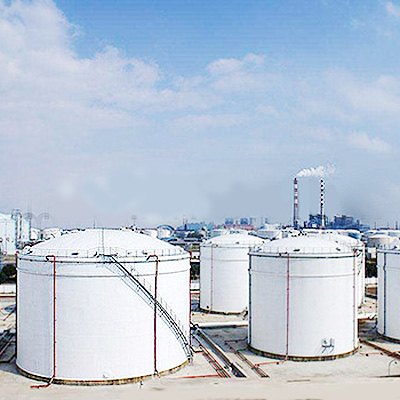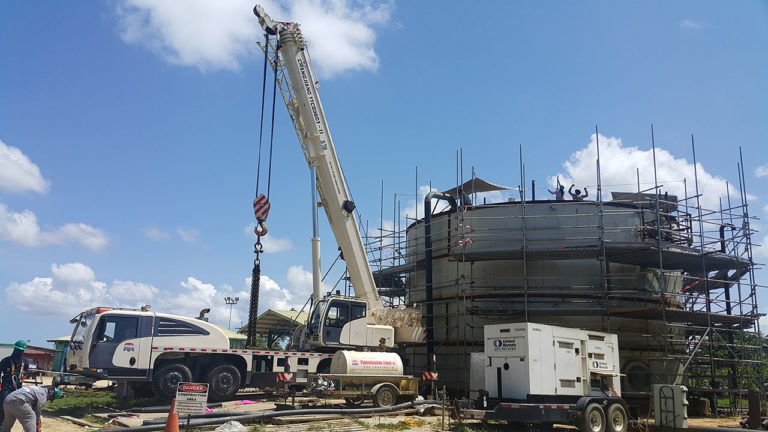The Future of API 650 Welding Inspection with Advanced Tools Integration
Wiki Article
Everything About Welding Examination: Secret Advantages for Your Projects
Welding evaluation plays an essential duty in the construction and production markets. It assures that bonded joints meet quality and safety criteria. By determining defects early, projects can stay clear of financial losses and significant hold-ups. Abiding by sector standards not just protects the integrity of the end product yet likewise builds count on amongst stakeholders. Recognizing the subtleties of this procedure discloses extra benefits that can impact job results considerably. What are these benefits?Comprehending the Welding Inspection Refine
Welding is an important component in numerous sectors, the evaluation process is important to assure high quality and safety and security. This procedure includes a collection of methodical examinations created to recognize any kind of potential issues that may jeopardize the stability of welded joints. At first, assessors evaluate welding procedures and certifications to validate compliance with industry criteria.Following this, aesthetic assessments are performed to examine the overall appearance and surface of welds. Non-destructive testing methods, such as radiographic or ultrasonic testing, may additionally be employed to find internal problems without damaging the product. Documentation plays a vital function, as it provides a document of evaluations and findings, validating traceability and liability.
Inevitably, understanding the welding evaluation procedure promotes confidence in the high quality of the finished product, minimizes the threat of failures, and improves general job success in various applications, from construction to production. API 650 Welding Inspection.
Typical Kinds Of Welding Problems
Welding flaws can significantly impact the stability and efficiency of welded frameworks, as they may lead to failings under stress or adverse conditions. Typical kinds of welding issues include splits, porosity, incomplete blend, and slag incorporation. Fractures can create because of thermal stresses or incorrect cooling, endangering the joint's toughness. Porosity describes the visibility of gas bubbles trapped in the weld, which can weaken the joint and decrease ductility. Insufficient blend happens when the weld steel does not properly bond with the base product, causing weak spots. Slag inclusion happens when non-metallic contaminations become caught within the weld, resulting in a decrease in architectural stability. Determining these problems early via assessment is vital for preserving high quality and ensuring security in bonded frameworks. Comprehending these typical problems enables boosted welding strategies and improved job results.Relevance of Conformity With Sector Requirements
Conformity with market criteria is crucial for maintaining structural stability in welding projects. Adhering to these requirements not only reduces liability risks yet additionally boosts the overall quality of the completed work. This positioning cultivates trust fund amongst stakeholders and assurances that projects satisfy both safety and security and efficiency assumptions.Making Sure Structural Stability
Guaranteeing structural stability is paramount in any kind of building or production job, as adherence to industry requirements functions as a structure for safety and reliability. Compliance with these criteria assurances that welding processes satisfy rigorous specs, which is essential for the longevity of frameworks. Regular welding inspections confirm that materials and strategies align with established standards, protecting against possible failures that can endanger honesty. Furthermore, adhering to sector criteria promotes uniformity in quality, which is vital for maintaining public rely on construction practices. By prioritizing structural integrity with attentive adherence to requirements, companies can enhance the overall performance of their projects, resulting in more secure atmospheres and prolonged property life-spans. Eventually, this dedication mirrors an aggressive approach to quality control in welding methods.Decreasing Liability Risks
Sticking to market requirements considerably alleviates responsibility threats associated with welding jobs. Conformity with developed standards assurances that welds satisfy security and efficiency criteria, minimizing the probability of failings that can cause accidents or litigation. This proactive approach not just secures the workforce yet likewise safeguards the monetary interests of the business. Second-rate practices or inadequate assessments can lead to pricey repair work, legal disagreements, and damage to credibility. By executing rigorous welding assessments, firms demonstrate their dedication to high quality and security, ultimately minimizing exposure to possible cases. On top of that, adherence to regulations enhances count on among stakeholders and customers, as it shows a dedication to maintaining high criteria throughout the job lifecycle. Decreasing liability threats is vital for lasting company sustainability.Enhancing Project Top Quality
Extensive welding assessments not only alleviate obligation threats but also play a critical role in enhancing general project high quality. By sticking to sector standards, these assessments guarantee that welds fulfill specified standards for safety and security, toughness, and durability. Conformity with developed standards assists determine defects early, minimizing the possibility of pricey rework or job delays. Moreover, constant top quality control cultivates trust amongst stakeholders, consisting of clients and regulative bodies, which can cause duplicate company and favorable recommendations. Eventually, a commitment to high-grade welding methods not just enhances the stability of the final product yet also maintains the credibility of the company entailed. Subsequently, comprehensive assessments act as a cornerstone for effective and lasting project outcomes.
Advantages of Very Early Detection of Issues
Early detection of welding problems provides substantial advantages, specifically regarding price savings on fixings. By identifying problems prior to they rise, organizations can boost the architectural honesty of their tasks. This proactive method not just minimizes economic expenses but likewise advertises safety and reliability in welded structures.
Price Savings on Repairs
Spotting welding issues immediately can lead to significant cost savings on fixings. Early identification of issues enables targeted treatments, minimizing the level of damage and stopping costly, extensive repairs in the future. When issues are attended to during the initial phases of a task, resources are made use of extra successfully, minimizing both labor and material prices. Furthermore, timely evaluations can protect against project hold-ups, which commonly sustain additional costs. By fixing problems early, firms can stay clear of the monetary worry related to rework, service warranty cases, visit this site and possible safety hazards. Ultimately, purchasing proactive welding examinations cultivates an extra cost-effective method to project management, ensuring that spending plans remain undamaged while maintaining the quality and integrity of the final product.Boosted Architectural Integrity
Making certain the structural integrity of welded elements rests on the timely recognition of prospective concerns. Early detection throughout the welding examination procedure enables the prompt rectification of issues such as fractures, spaces, or inappropriate combination. Dealing with these issues quickly not just enhances the toughness and resilience of the weld yet additionally minimizes the danger of catastrophic failures throughout the life span of the structure. Routine inspections add to an extra trustworthy analysis of weld top quality, ensuring conformity with industry criteria. By prioritizing welding examinations, task supervisors can preserve a greater degree of safety and security and efficiency, ultimately leading to successful job results. Improved structural integrity reflects the commitment to high quality and adherence to best techniques in welding.Cost-Effectiveness of Welding Inspections
While numerous companies might see welding inspections as an added cost, they often verify to be a cost-efficient investment in the lengthy run. By recognizing issues early, these evaluations can protect against costly repairs or substitutes that might occur from undiscovered issues. This aggressive strategy not only conserves money however also decreases job hold-ups, guaranteeing that timelines are abided by.
Top notch welding assessments contribute to improved effectiveness, leading to less rework instances and boosted productivity. The reduction in product waste and labor costs connected with remodeling faulty welds includes to the monetary advantages.
Purchasing comprehensive examinations likewise boosts the overall high quality of the end product, which can result in enhanced customer complete satisfaction and repeat organization. Ultimately, the first costs connected with welding examinations are typically surpassed by the long-term cost savings and benefits they offer, making them a wise choice for any kind of welding job.
Enhancing Security and Integrity in Welding Projects

Welding assessments play an essential function in improving security and dependability within welding projects, as they systematically determine potential hazards and weaknesses in welds. By using qualified assessors, organizations can assure that welding processes stick to industry standards and regulative needs. This proactive approach reduces the danger of weld failures, which can result in mishaps, pricey repairs, and job delays.
Evaluations offer necessary documents that shows compliance and top quality guarantee, promoting depend on between stakeholders. Routine assessments throughout various task phases enable the timely discovery of issues, enabling restorative activities prior to they intensify. Additionally, the insights acquired from assessments add to continuous renovation in welding practices, boosting general project end results. Inevitably, robust welding inspection methods not only protect employees but additionally protect financial investments, assuring that jobs are completed successfully and fulfill the highest possible security and reliability standards.
Frequently Asked Inquiries
What Credentials Should a Welding Inspector Have?
A welding assessor must have pertinent certifications, such as Certified Welding Inspector (CWI), along with considerable knowledge of welding codes, materials, and procedures. API 650 Welding Inspection. Experience in the area and solid logical abilities are additionally crucial for effective evaluationsJust How Commonly Should Welding Inspections Be Carried Out?
Welding inspections should be performed consistently, usually before, during, and after the welding procedure. The frequency might depend on task specs, regulative requirements, and the complexity of the welds to guarantee structural integrity and safety and security.Can Welding Inspections Be Done Remotely?
Welding inspections can indeed be done from another location, making use of advanced modern technologies such as drones, cams, and ultrasonic screening tools - API 650 Welding Inspection. This method permits reliable surveillance while reducing the requirement for physical presence her latest blog at the websiteWhat Tools Are Utilized in Welding Inspections?
Welding evaluations utilize numerous tools, consisting of ultrasonic testers, magnetic bit testers, visual assessment devices, radiographic equipment, and calipers. Each tool offers a particular purpose to guarantee weld honesty, quality, and compliance with market requirements.How Do I Pick a Welding Inspection Solution?

To choose a welding inspection service, one need to examine certifications, experience, and certifications. about his Additionally, assessing client reviews and requesting comprehensive solution descriptions can assist ensure the selected service fulfills certain job needs properly.
By prioritizing welding evaluations, task supervisors can maintain a higher level of safety and security and performance, eventually leading to successful task end results. Welding evaluations play an important duty in improving safety and security and dependability within welding projects, as they systematically determine prospective hazards and weaknesses in welds. A welding assessor need to have pertinent certifications, such as Certified Welding Assessor (CWI), along with substantial knowledge of welding products, procedures, and codes. Welding inspections must be performed regularly, normally previously, throughout, and after the welding process. Welding examinations use various devices, consisting of ultrasonic testers, magnetic bit testers, aesthetic inspection tools, radiographic tools, and calipers.
Report this wiki page